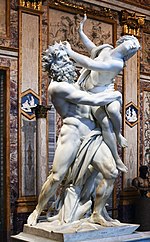Villa Borghese gardens
Art gallery districtsGardens in RomeMuseums in RomeOlympic equestrian venuesRome Q. I Flaminio ... and 6 more
Rome R. IV Campo MarzioRome R. XVI LudovisiTourist attractions in RomeVenues of the 1960 Summer OlympicsVilla BorgheseVillas in Rome

Villa Borghese is a landscape garden in Rome, containing a number of buildings, museums (see Galleria Borghese) and attractions. It is the third-largest public park in Rome (80 hectares or 197.7 acres), after the ones of the Villa Doria Pamphili and Villa Ada. The gardens were developed for the Villa Borghese Pinciana ("Borghese villa on the Pincian Hill"), built by the architect Flaminio Ponzio, developing sketches by Scipione Borghese, who used it as a villa suburbana, or party villa, at the edge of Rome, and to house his art collection. The gardens as they are now were remade in the late 18th century.
Excerpt from the Wikipedia article Villa Borghese gardens (License: CC BY-SA 3.0, Authors, Images).Villa Borghese gardens
Piazzale del Museo Borghese, Rome Pinciano
Geographical coordinates (GPS) Address Nearby Places Show on map
Geographical coordinates (GPS)
| Latitude | Longitude |
|---|---|
| N 41.914166666667 ° | E 12.492222222222 ° |
Address
Casino Nobile di Villa Borghese
Piazzale del Museo Borghese 5
00197 Rome, Pinciano
Lazio, Italy
Open on Google Maps










